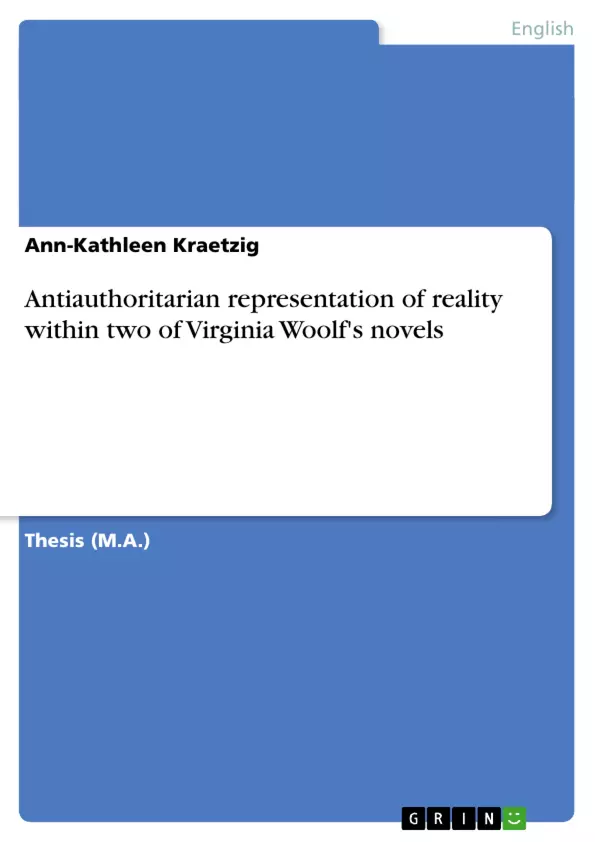“Catch me if you can” was the invitation Virginia Woolf tried to meet in various ways
during her career as a writer. This invitation had been uttered by a character in Woolf’s
essay Mr Bennet and Mrs Brown1, where she expresses her intention to catch reality
within her novels. The discussion of representation of reality has a long tradition.
Before Virginia Woolf began to think about the concept of reality, the Edwardians tried
to transfer reality to their novels by presenting detailed descriptions of the outer world.
When the modern writers emerged, they turned their backs on the traditional novel and
adopted the current interest in psychology into their works by concentrating on the
individual mind. In this context, Virginia Woolf’s thoughts and theories are very
interesting as she criticised both, the Edwardians as well as some modern writers. That
is, she was neither convinced by the technique of the Edwardians, nor by the way her
contemporaries approached the psychological representation of reality. She felt
disappointed by the former mainly because of their detailed description of the outer
world which she regarded as superfluous, and blamed the latter for their monological,
unrestricted representation of the mind. Although Woolf supported the modern tradition
to concentrate on the mind rather than on plot, she had an aesthetical claim which was
incompatible with the erratic stream of consciousness technique. Additionally, she
questioned the objectivity of a monological representation and searched for new ways to
catch and represent reality. The problem was thus, how to convert her intentions into
her writing.
Inhaltsverzeichnis (Table of Contents)
- Introduction
- Virginia Woolf's concept of reality
- New literary strategies
- Multiperspectivity
- Bakhtin's Dialogism
- The dialogic subject
- Woolf in dialogue with the world
- Dialogue within the novel
- Poetry
- Impact on the reader
- Horizon of expectation
- New narrative strategies to liberate the reader?
- Multiperspectivity
- To the Lighthouse
- Coherence
- Connection of the scenes
- Concentration on the mind
- Moments of Unity
- Dynamic reality
- The dialogue between Lily and Mrs Ramsay
- Characters as narrators
- Multiperspectivity to create objectivity?
- Poetry within the novel
- Inadequacy of language to express emotions
- Metaphors
- Water/Sea
- Light
- Journey
- Music and rhythm
- The role of the reader
- Between the Acts
- Uniting structure
- The permeable mind
- The dynamic voice
- Polyphony
- Between acts
- Poetry
- Metaphors
- Water
- Light
- A leader
- Silence
- Mirror Modes
- Others
- Metaphors
- A play in a play
- Fears of the artist
- Oscillation between fiction and reality
- Advising the reader
Zielsetzung und Themenschwerpunkte (Objectives and Key Themes)
This work aims to explore Virginia Woolf's theoretical concept of reality and its representation in two of her novels, To the Lighthouse and Between the Acts. It examines her innovative literary techniques, focusing on how she moved beyond traditional narrative methods. The analysis will delve into her approach to representing reality, contrasting it with earlier and contemporary literary styles.
- Woolf's concept of reality and its representation in her novels.
- The use of multiperspectivity and polyphony to avoid an authoritarian narrator.
- The role of dialogue and its impact on the reader's experience.
- The significance of poetic devices, such as metaphors, in conveying meaning.
- The innovative narrative strategies employed to engage the reader.
Zusammenfassung der Kapitel (Chapter Summaries)
The Introduction establishes the context of Virginia Woolf's approach to representing reality, contrasting her methods with those of Edwardian and modernist writers. The chapter on Virginia Woolf's concept of reality and new literary strategies lays the groundwork for analyzing her techniques, including multiperspectivity and the use of poetic language. The analysis of To the Lighthouse will examine the novel's structure, its focus on the inner lives of the characters, and the use of poetic imagery to convey emotion. The analysis of Between the Acts will similarly focus on its structural elements and narrative strategies, without revealing major plot points or conclusions.
Schlüsselwörter (Keywords)
Virginia Woolf, reality, representation, multiperspectivity, polyphony, dialogue, narrative strategy, modernism, To the Lighthouse, Between the Acts, poetic language, metaphor.
- Quote paper
- Ann-Kathleen Kraetzig (Author), 2008, Antiauthoritarian representation of reality within two of Virginia Woolf's novels, Munich, GRIN Verlag, https://www.grin.com/document/122403



